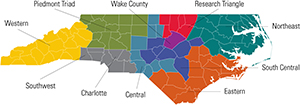What is Needs Assessment?
Needs assessment is a process for determining an organization’s needs. It usually consists of three main parts:
- Initiation
- Data Collection & Analysis
- Final Production
A needs assessment is the “what” (what the organization needs) that precedes the gap analysis, which is the “how” (how to close the gap between where the organization is currently and where they want or need to be).
Why is it Important?
At a busy company there are so many things going on, that it is hard to pin down exactly what may be holding it back. Needs assessment is important because it helps an organization determine the gaps that are preventing it from reaching its desired goals. In A Guide to Performing a Needs Assessment and a Gap Analysis, Anthony J. Jannetti says these gaps can exist in either knowledge, practices, or skills. Knowing what is working well and what needs to be changed is crucial to progressing effectively towards those goals and making an organization successful.
Needs assessment addresses these concerns from all levels, starting at the 30,000 foot view and drilling down further and further into the individual organization, to arrive at a plan with specific actions for improvement.
How Does it Work?
Sometimes we may know what tool is ideal for a situation, but we might not know how to use that tool. For instance, we may find ourselves in a sushi restaurant and the waiter hands us a pair of chopsticks, but if we don’t have experience eating with chopsticks we will not be able to use them effectively.
We know that needs assessment is the appropriate tool but we have not yet explored how to conduct it. To illustrate needs assessment, we will use a fictitious company throughout this blog series named Wants and Needs, Inc. Wants and Needs, Inc. struggles with high employee turnover, and its management wonders if some kind of training program might be effective in helping the company retain its workers.
The decision should not be undertaken in a vacuum. There are many factors to consider, including the external environment the company exists within (such as the existing software tools that could be used to build the training), how the company interacts with the external environment (such as determining any appropriate training courses or materials that already exist), what the company’s strengths and weaknesses are (such as if the company can create its own effective training), as well as the things the company already does well and those that they need to improve upon.
After lengthy consideration, Wants and Needs Inc. decides to introduce a formal mentorship program in their organization. They hope that providing more career growth opportunities will help combat high employee turnover. They have engaged a consultant to conduct needs assessment and we will follow them through the various stages of the needs assessment process as we discover how it works.
Now that we understand the three main parts of needs assessment are initiation, data collection & analysis, and final product, let’s explore how to do each of these parts.
- Initiation:
Initiation starts out by identifying the “frame factors,” otherwise known as “limiting factors,” for the needs assessment project, the organization being analyzed, and the project stakeholders.
(Some of these limiting factors will not become apparent until after meeting with the client, which comes next. As Peter Block discusses in his book, Flawless Consulting, this customer meeting allows for the exploration of the problems as well as to align the expectations of both the client and the consultant.)
Next, the consultant creates a project proposal and both the consultant and Needs and Wants Inc. enter into a verbal or written contract.
The final step of initiation is a kick-off meeting to determine the next steps.
- Data Collection & Analysis:
Data collection & analysis follows the initiation stage. During this stage, we perform a PEST (political, economic, social, and technological) analysis and SWOT (Strengths, Weaknesses, Opportunities and Threats) analysis, and collect data. PEST analysis happens first and it examines the macro-level factors that make up the environment that the organization exists within. These factors are external to the organization itself and include the political, economic, social, and technological factors. The PEST analysis comes first because it occurs from the broadest vantage point and can help identify roadblocks in the environment.
Next, SWOT analysis attempts to identify the strengths and weakness, which are internal to the company, as well as the opportunities and threats, which are external to the company. SWOT analysis includes some external factors, but it starts to narrow its scope, compared to the PEST analysis.
Then, we collect data. We conduct interviews, observe, give surveys, and review existing documents. Using these diverse methods ensures triangulation–revealing trends and painting a more accurate picture of what is occurring.
Data collection & analysis is, of course, the analysis of the data we’ve collected. We review the PEST analysis results to get the big picture, review the SWOT analysis results to determine areas of success as well as areas of concern, and we analyze all data that has been collected.
- Final Product:
The third and final phase of the needs assessment is the final product. This include a summary of the findings, the migration strategy detailing which driving forces should be strengthened and which restraining forces should be limited, and a final report that includes recommendations.
In “Tips for Mentoring Employees, Part 1: What’s a Mentor?” and “Tips for Mentoring Employees, Part 2: How to Mentor Successfully”, we discussed how mentorship is valuable for mentors, mentees, and the companies that they work for. In the next few parts of this blog post, we will continue to use the theme of mentorship to demonstrate how to conduct a needs assessment.
Throughout this multiple part blog post, as we follow Wants and Needs, Inc., we will explore the various aspects of needs assessment in more detail, diving into PEST analysis, SWOT analysis, and a migration strategy involving Force Field analysis.
The next post will explain in detail how to conduct a PEST analysis–stay tuned.
Is your organization getting ready to start a needs assessment? Have additional questions? Drop us a line.
Click here to continue reading: How to Conduct Needs Assessment Part 2: PEST Analysis ➤
Alex Weisberg serves as an Instructional Designer on the Professional Learning and Instructional Design team for NC State Industry Expansion Solutions (IES). His focus is on working with subject matter experts to design, develop, and assess training content to ensure it is engaging and effective. Prior to joining IES, Alex worked at PTC as an Education Editor Specialist. He holds a bachelor’s degree in English from the University of Michigan and a master’s degree in Instructional Systems Technology from Indiana University. His experience in adult education spans over 6 years working with subject matter experts to improve and develop training materials.




